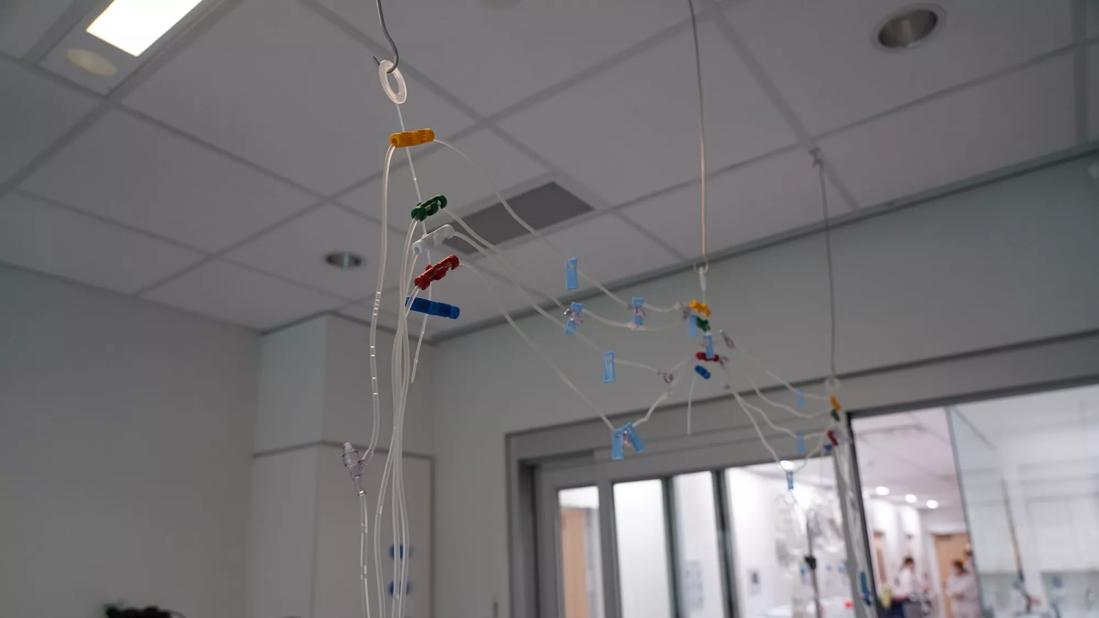Invention is fast tracked to help manage patient IV lines

For patients’ with COVID-19 and other patients requiring isolation in intensive care units, caregivers use an average of 66 pieces of personal protective equipment (PPE) each day. This high number is partially driven by the need to enter patient rooms repeatedly to manage intravenous (IV) and other pumps that deliver necessary medications and nutrition.
Advertisement
Cleveland Clinic is a non-profit academic medical center. Advertising on our site helps support our mission. We do not endorse non-Cleveland Clinic products or services. Policy
Earlier this year, Cleveland Clinic critical care units began moving IV and nutritional pumps outside of patient isolation rooms to preserve their stock of PPE. To achieve this new nursing practice, nurses added additional IV extension sets to each IV line resulting in IV tubing laying on the floor. Immediately, potential safety issues were identified, such as tripping over lines and line dislodgement. Nurses initially used solutions that other healthcare systems recommended online, however, these solutions did not completely solve the safety issues.
Enter an internal nursing innovation that mitigated the safety issues of dealing with long IV tubing.
Previous to COVID-19, advanced practice pediatric nurse Jane Hartman MSN, APRN-PNP-BC, had developed a product called the High-LineTM, which she created for the purpose of keeping long lines of IV tubing up and off of hospital floors while patients were ambulating. This is a frequent problem in the pediatric population, as IV tubing is a standard length and children are small. When the COVID-19 surge happened in March, Hartman was in the process of initiating a research study to assess the value of her innovation.
Hartman immediately met with her High-Line co-developer, Nancy Albert, PhD, CCNS, NE-BC, FAAN, Cleveland Clinic’s Associate CNO of Research and Innovation. The two discussed the critical care nursing needs and how they might revise the High-Line to meet these needs. “We recognized that the High-Line would need to raise more than one tubing off the floor concurrently,” says Dr. Albert. “And there needed to be flexibility because some ICU doors close in the middle and others close on one side, close to a wall.”
Advertisement
Today, the High-Line is a two-part system, a 10-inch silicon stem with small cones every inch and an O-ring that allows placement on a wall or ceiling hook. The stem is flexible and can stretch to prevent tension on IV or enteral insertion sites when tubing manipulation occurs. Plastic cradles are used to secure tubing in place and can easily be added or removed from the stem. As part of the adaptation for ICU use where patients often require multiple lines, the High-Line allows for up to eight cradles per stem. The cradles come in five colors, which provides an additional safety feature by allowing nurses to follow lines of medication more easily from pumps to the patient.
In a typical critical care room, it can take up to three High-Lines to keep tubing off the floor, including one near the door where tubing meets pumps and one or two overhead or along a wall. The right number is based on the overall length of tubing and the distance from patient bed to critical care doors. Another adaptation was the addition of a ceiling pole to allow the use of ceiling hooks (purchased commercially) to secure the device in place.
Dr. Albert and Hartman say they were fortunate to have a team from Cleveland Clinic Innovations and Lerner Research Institute’s Medical Device Solutions (MDS) to assist in every step of development.
“We completed paperwork associated with patent and trademark registration, and importantly, worked with engineers and prototyping production experts to bring our first and subsequent prototypes to life. The team was very interested in the evaluations we received from end users of each iteration of the product,” says Dr. Albert.
Advertisement
“Getting feedback from users was a really important step of the process,” says Hartman. “For example, we were pleased to discover that the product can hold oxygen and continuous renal replacement therapy tubing in addition to IV and enteral feeding tubing.”
She adds: “As an inventor, it has been gratifying and a bit overwhelming to watch the evolution of this invention, from sketches to different iterations to being deployed and effectively used in the critical care setting. We wanted to assist in the safety of our colleagues and patients during the COVID-19 crisis and beyond, and we are so pleased by the positive feedback.” Ultimately, the High-Line has proven to be an effective, affordable and disposable way to manage patient tubing and keep patients and caregivers safe.
Cleveland Clinic has made the device available for other hospitals to use during transitional practices associated with COVID-19.
Advertisement
Advertisement

Patients report improved sense of smell and taste

Clinicians who are accustomed to uncertainty can do well by patients

Unique skin changes can occur after infection or vaccine

Cleveland Clinic analysis suggests that obtaining care for the virus might reveal a previously undiagnosed condition

As the pandemic evolves, rheumatologists must continue to be mindful of most vulnerable patients

Early results suggest positive outcomes from COVID-19 PrEP treatment

Could the virus have caused the condition or triggered previously undiagnosed disease?

Five categories of cutaneous abnormalities are associated with COVID-19